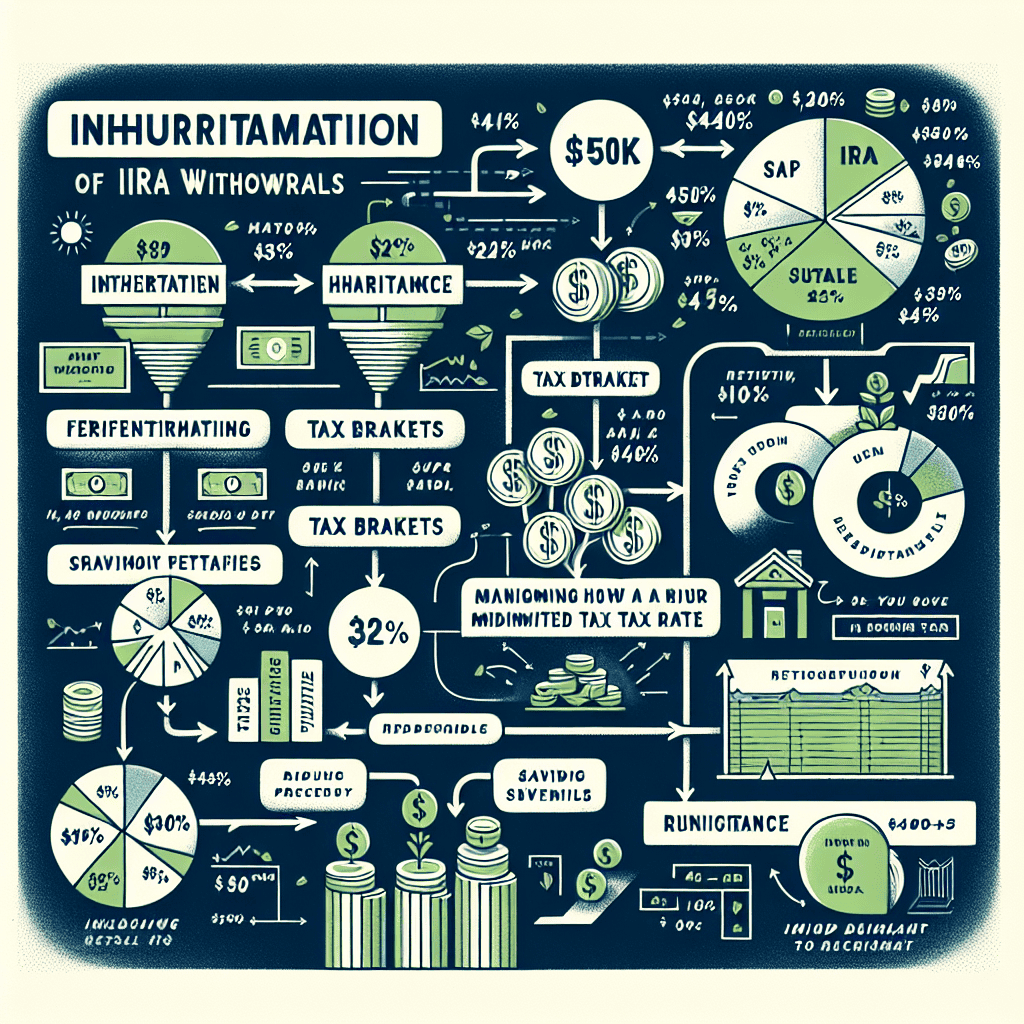“Maximize Your Legacy: Smart IRA Withdrawals for a $450k Inheritance in a 32% Tax Bracket”
Introduction
Inheriting a substantial sum, such as $450,000, can significantly impact one’s financial landscape, particularly when it involves an Individual Retirement Account (IRA). For individuals in a 32% tax bracket, optimizing IRA withdrawals becomes crucial to minimize tax liabilities and maximize the inheritance’s long-term benefits. This process involves strategic planning to navigate the complexities of tax regulations, withdrawal timing, and investment growth. By understanding the nuances of IRA withdrawal strategies, beneficiaries can effectively manage their inheritance, ensuring that they retain as much of the funds as possible while adhering to tax obligations. This guide explores key considerations and strategies for optimizing IRA withdrawals, providing a roadmap for managing a $450,000 inheritance within a high tax bracket.
Understanding IRA Withdrawal Strategies: Minimizing Tax Impact on a $450k Inheritance
Inheriting a substantial sum, such as $450,000 in an Individual Retirement Account (IRA), presents both opportunities and challenges, particularly when the beneficiary is in a 32% tax bracket. Understanding the intricacies of IRA withdrawal strategies is crucial to minimizing the tax impact and maximizing the financial benefits of such an inheritance. The first step in this process is recognizing the tax implications associated with traditional IRAs. Withdrawals from these accounts are typically taxed as ordinary income, which can significantly increase the beneficiary’s taxable income and, consequently, their tax liability. Therefore, strategic planning is essential to mitigate these effects.
One effective strategy is to spread the withdrawals over several years. By doing so, the beneficiary can potentially avoid being pushed into a higher tax bracket, thereby reducing the overall tax burden. This approach, known as a “stretch IRA” strategy, allows the beneficiary to take required minimum distributions (RMDs) based on their life expectancy, thus extending the tax-deferred growth of the remaining funds. However, it is important to note that recent changes in legislation, specifically the SECURE Act, have altered the landscape for inherited IRAs. The act mandates that most non-spouse beneficiaries must deplete the account within ten years of the original owner’s death, which necessitates careful planning to optimize tax outcomes.
Another consideration is the timing of withdrawals. If the beneficiary anticipates a lower income year, it may be advantageous to take larger distributions during that period to take advantage of a lower tax rate. Conversely, in years of higher income, minimizing withdrawals can help avoid additional tax burdens. This requires a thorough understanding of one’s financial situation and future income projections, underscoring the importance of personalized financial planning.
Moreover, beneficiaries should explore the possibility of converting the inherited IRA into a Roth IRA. While this strategy involves paying taxes on the converted amount upfront, it offers the benefit of tax-free withdrawals in the future. This can be particularly advantageous if the beneficiary expects to be in a higher tax bracket later in life. However, the decision to convert should be made with caution, as it requires a careful analysis of current and projected tax rates, as well as the availability of funds to cover the immediate tax liability.
In addition to these strategies, beneficiaries should also consider the impact of state taxes on their inheritance. State tax laws vary significantly, and understanding these nuances can further optimize the tax efficiency of IRA withdrawals. Consulting with a tax professional or financial advisor who is well-versed in both federal and state tax regulations can provide invaluable guidance in this regard.
Ultimately, managing a $450,000 IRA inheritance in a 32% tax bracket requires a comprehensive approach that takes into account both immediate and long-term financial goals. By employing a combination of strategic withdrawal timing, potential Roth conversions, and an awareness of legislative changes, beneficiaries can effectively minimize the tax impact and preserve the value of their inheritance. As with any complex financial decision, seeking professional advice tailored to one’s unique circumstances is a prudent step in ensuring that the inherited wealth is managed optimally.
Timing Your IRA Withdrawals: How to Optimize Tax Efficiency in a 32% Tax Bracket
When managing a $450,000 inheritance within an Individual Retirement Account (IRA) while situated in a 32% tax bracket, strategic planning becomes essential to optimize tax efficiency. The complexity of tax regulations and the potential financial implications necessitate a well-thought-out approach to timing IRA withdrawals. Understanding the nuances of tax brackets and withdrawal strategies can significantly impact the net value of the inheritance.
Initially, it is crucial to recognize the implications of the 32% tax bracket. This bracket indicates a relatively high-income level, where a substantial portion of any additional income, such as IRA withdrawals, will be subject to significant taxation. Therefore, the primary objective is to minimize the tax burden while maximizing the inheritance’s value. One effective strategy is to spread the withdrawals over several years. By doing so, it is possible to avoid a sudden spike in taxable income, which could push the individual into an even higher tax bracket. This approach requires careful planning and a thorough understanding of current and projected income levels.
Moreover, considering the timing of withdrawals in relation to other income sources is vital. For instance, if there are years with lower income, it might be advantageous to increase IRA withdrawals during those periods. This tactic can help maintain a consistent tax rate and prevent unnecessary escalation into higher tax brackets. Additionally, it is essential to be aware of the Required Minimum Distributions (RMDs) that must begin at age 72. Failing to take these distributions can result in substantial penalties, further complicating the tax situation.
Another consideration is the potential for Roth conversions. Converting a traditional IRA to a Roth IRA can be a strategic move, especially if future tax rates are expected to rise. Although the conversion itself is a taxable event, it allows for tax-free growth and withdrawals in the future. This strategy can be particularly beneficial if executed during years of lower income, thereby minimizing the immediate tax impact. However, it is crucial to conduct a thorough analysis to ensure that the long-term benefits outweigh the short-term costs.
Furthermore, charitable contributions can play a significant role in optimizing tax efficiency. Qualified Charitable Distributions (QCDs) allow individuals over 70½ to donate up to $100,000 directly from their IRA to a qualified charity. This donation is excluded from taxable income, providing a dual benefit of supporting charitable causes while reducing the taxable amount of the IRA withdrawal. This strategy can be particularly advantageous for those who are charitably inclined and seeking to reduce their tax liability.
In addition to these strategies, consulting with a financial advisor or tax professional is highly recommended. These experts can provide personalized advice tailored to individual circumstances, ensuring that all factors are considered in the decision-making process. They can also assist in navigating the complex tax regulations and identifying opportunities for further optimization.
In conclusion, managing a $450,000 inheritance within an IRA while in a 32% tax bracket requires a strategic approach to timing withdrawals. By spreading withdrawals over several years, considering Roth conversions, utilizing charitable contributions, and seeking professional guidance, it is possible to optimize tax efficiency and maximize the inheritance’s value. Through careful planning and informed decision-making, individuals can navigate the complexities of the tax system and achieve their financial goals.
Balancing Inheritance and Tax Obligations: Smart IRA Withdrawal Planning
Inheriting a substantial sum, such as $450,000, can be both a blessing and a challenge, particularly when it comes to managing tax obligations. For individuals in a 32% tax bracket, optimizing IRA withdrawals becomes crucial to ensure that the inheritance is preserved and grown effectively. The key lies in balancing the immediate financial needs with long-term tax efficiency, thereby maximizing the benefits of the inheritance while minimizing the tax burden.
To begin with, understanding the tax implications of IRA withdrawals is essential. Traditional IRAs are subject to income tax upon withdrawal, which means that any amount taken out will be added to the individual’s taxable income for that year. For someone in a 32% tax bracket, this can significantly increase the tax liability. Therefore, strategic planning is necessary to avoid unnecessary tax penalties and to make the most of the inherited funds.
One effective strategy is to spread out the withdrawals over several years. By doing so, the individual can potentially keep their taxable income within a lower bracket, thereby reducing the overall tax rate applied to the withdrawals. This approach not only helps in managing the tax impact but also allows the remaining funds in the IRA to continue growing tax-deferred. Moreover, it provides the flexibility to adjust the withdrawal amounts based on changing financial needs and tax laws.
Another consideration is the potential use of Roth conversions. Converting a portion of the traditional IRA into a Roth IRA can be advantageous, especially if the individual anticipates being in a higher tax bracket in the future. While the conversion itself is a taxable event, the funds in the Roth IRA grow tax-free, and qualified withdrawals are also tax-free. This strategy requires careful analysis of current and projected tax rates, as well as the individual’s financial goals.
In addition to these strategies, it is important to consider the impact of required minimum distributions (RMDs). Once the individual reaches the age of 73, RMDs must be taken from traditional IRAs, which can increase taxable income. Planning withdrawals in advance can help manage the size of RMDs and their tax implications. For those who inherit an IRA, the SECURE Act mandates that the account be fully distributed within ten years, adding another layer of complexity to withdrawal planning.
Furthermore, consulting with a financial advisor or tax professional can provide valuable insights tailored to the individual’s specific situation. These experts can help navigate the intricacies of tax laws and develop a comprehensive plan that aligns with both short-term needs and long-term objectives. They can also assist in exploring other investment opportunities that may offer tax advantages, such as municipal bonds or tax-efficient mutual funds.
In conclusion, managing a $450,000 inheritance within a 32% tax bracket requires a thoughtful approach to IRA withdrawals. By spreading out withdrawals, considering Roth conversions, and planning for RMDs, individuals can effectively balance their inheritance with tax obligations. Engaging with financial professionals further enhances this process, ensuring that the inherited funds are utilized in the most tax-efficient manner possible. Through careful planning and strategic decision-making, it is possible to preserve and grow the inheritance while minimizing the tax impact, ultimately securing a more stable financial future.
Exploring Roth Conversions: A Strategy for Managing a $450k Inheritance

When managing a $450,000 inheritance within a 32% tax bracket, strategic financial planning becomes essential to optimize the benefits of an Individual Retirement Account (IRA). One effective strategy to consider is the Roth conversion, which can offer significant tax advantages and long-term financial benefits. Understanding the intricacies of this approach is crucial for making informed decisions that align with your financial goals.
Initially, it is important to recognize the fundamental differences between a traditional IRA and a Roth IRA. Traditional IRAs allow for tax-deferred growth, meaning that contributions are made with pre-tax dollars, and taxes are paid upon withdrawal during retirement. In contrast, Roth IRAs are funded with after-tax dollars, allowing for tax-free growth and tax-free withdrawals in retirement. This distinction is pivotal when considering a Roth conversion, as it involves transferring funds from a traditional IRA to a Roth IRA, thereby incurring taxes on the converted amount in the year of conversion.
Given the substantial inheritance and the 32% tax bracket, a Roth conversion may initially seem daunting due to the immediate tax implications. However, the long-term benefits often outweigh the short-term costs. By converting a portion of the inherited IRA to a Roth IRA, you can lock in the current tax rate, potentially avoiding higher taxes in the future. This is particularly advantageous if you anticipate being in a higher tax bracket during retirement or if tax rates are expected to rise.
Moreover, a Roth conversion can provide greater flexibility in retirement planning. Unlike traditional IRAs, Roth IRAs do not have required minimum distributions (RMDs) during the account holder’s lifetime. This allows for more control over the timing and amount of withdrawals, which can be strategically managed to minimize tax liabilities and maximize the growth potential of the remaining funds. Additionally, Roth IRAs can be an effective estate planning tool, as they can be passed on to heirs tax-free, providing a lasting financial legacy.
To effectively implement a Roth conversion strategy, it is essential to consider the timing and amount of conversions. Spreading the conversions over several years can help manage the tax burden by preventing a significant spike in taxable income in any given year. This approach, known as a “laddered” conversion, allows for a gradual transition of funds while maintaining control over the tax impact. Furthermore, it is advisable to conduct a thorough analysis of your current and projected financial situation, taking into account factors such as expected income, potential changes in tax legislation, and retirement goals.
In addition to timing, it is crucial to evaluate the source of funds for paying the taxes incurred by the conversion. Ideally, taxes should be paid from sources outside the IRA to preserve the full value of the converted amount, thereby maximizing the growth potential within the Roth IRA. This requires careful cash flow management and may involve utilizing other assets or income streams to cover the tax liability.
In conclusion, exploring Roth conversions as a strategy for managing a $450,000 inheritance within a 32% tax bracket can offer significant advantages. By understanding the nuances of this approach and carefully planning the timing and execution of conversions, you can optimize your IRA withdrawals, enhance your retirement planning, and secure a tax-efficient financial future. As with any complex financial decision, consulting with a financial advisor or tax professional is recommended to tailor the strategy to your specific circumstances and ensure compliance with current tax laws.
The Role of Required Minimum Distributions in Optimizing IRA Withdrawals
When managing a $450,000 inheritance within an Individual Retirement Account (IRA) while situated in a 32% tax bracket, understanding the role of Required Minimum Distributions (RMDs) becomes crucial. RMDs are the minimum amounts that a retirement account owner must withdraw annually, starting at age 72, from their IRA, 401(k), or other retirement accounts. These distributions are mandated by the Internal Revenue Service (IRS) to ensure that individuals do not defer taxes indefinitely. For those inheriting an IRA, the rules surrounding RMDs can significantly impact the strategy for optimizing withdrawals, especially when considering the tax implications.
Initially, it is essential to recognize that the SECURE Act of 2019 brought significant changes to the landscape of inherited IRAs. One of the most notable changes is the introduction of the 10-year rule for non-spouse beneficiaries. Under this rule, the entire balance of the inherited IRA must be distributed by the end of the tenth year following the original account holder’s death. This regulation eliminates the option for non-spouse beneficiaries to stretch distributions over their lifetime, which previously allowed for more extended tax deferral and potentially lower annual tax liabilities.
Given the constraints of the 10-year rule, beneficiaries in a high tax bracket, such as the 32% bracket, must carefully strategize their withdrawals to minimize tax burdens. One approach is to consider the timing and size of distributions within the 10-year period. By analyzing one’s current and projected future income, beneficiaries can determine the most tax-efficient years to take larger distributions. For instance, if a beneficiary anticipates a lower income year due to retirement or other factors, it may be advantageous to take a more substantial distribution during that year to take advantage of a lower tax rate.
Moreover, beneficiaries should explore the possibility of converting portions of the inherited IRA into a Roth IRA. While this strategy involves paying taxes on the converted amount upfront, it can be beneficial in the long run. Roth IRAs do not have RMDs during the account owner’s lifetime, and qualified withdrawals are tax-free. This conversion can be particularly advantageous if the beneficiary expects to be in a higher tax bracket in the future or if they wish to leave a tax-free inheritance to their heirs.
Additionally, it is important to consider the impact of RMDs on other aspects of financial planning. For example, large distributions can affect eligibility for certain tax credits or deductions and may also have implications for Medicare premiums, which are income-based. Therefore, a comprehensive approach that considers the broader financial picture is essential when planning IRA withdrawals.
In conclusion, optimizing IRA withdrawals when managing a $450,000 inheritance in a 32% tax bracket requires a nuanced understanding of RMDs and the strategic use of available options. By carefully planning the timing and size of distributions, considering Roth conversions, and evaluating the broader financial implications, beneficiaries can effectively manage their tax liabilities while maximizing the benefits of their inheritance. As tax laws and personal circumstances evolve, consulting with a financial advisor or tax professional can provide valuable guidance tailored to individual needs and goals.
Tax-Efficient Charitable Giving: Leveraging IRA Withdrawals for Philanthropy
When managing a $450,000 inheritance within a 32% tax bracket, optimizing IRA withdrawals becomes a crucial strategy, particularly when considering tax-efficient charitable giving. The intersection of philanthropy and financial planning offers a unique opportunity to minimize tax liabilities while supporting meaningful causes. By leveraging IRA withdrawals for charitable purposes, individuals can achieve both personal financial goals and philanthropic aspirations.
To begin with, understanding the tax implications of IRA withdrawals is essential. Traditional IRAs are funded with pre-tax dollars, meaning that withdrawals are subject to ordinary income tax rates. For individuals in a 32% tax bracket, this can result in a significant tax burden. However, by incorporating charitable giving into the withdrawal strategy, one can mitigate these taxes effectively. The Qualified Charitable Distribution (QCD) is a powerful tool in this regard. It allows individuals aged 70½ or older to directly transfer up to $100,000 per year from their IRA to a qualified charity, without the distribution being included in their taxable income. This not only reduces the taxable amount but also satisfies the required minimum distribution (RMD) obligations, thereby offering a dual benefit.
Moreover, the strategic use of QCDs can enhance the impact of charitable contributions. By directing IRA funds to charities, individuals can support causes they are passionate about while simultaneously reducing their taxable income. This approach is particularly advantageous for those who do not itemize deductions, as the QCD provides a tax benefit that is not contingent on itemizing. Furthermore, it allows for a more substantial philanthropic impact, as the full amount of the distribution goes to the charity, unencumbered by taxes.
In addition to QCDs, another strategy involves the timing and amount of IRA withdrawals. By carefully planning the timing of withdrawals, individuals can manage their taxable income more effectively. For instance, spreading withdrawals over several years can prevent a spike in income that might push them into a higher tax bracket. This approach requires a thorough understanding of one’s financial situation and future income projections, ensuring that withdrawals are optimized for both tax efficiency and personal financial needs.
Furthermore, individuals should consider the potential benefits of donor-advised funds (DAFs) in conjunction with IRA withdrawals. While DAFs do not offer the same immediate tax benefits as QCDs, they provide flexibility in charitable giving. By contributing to a DAF, individuals can take an immediate tax deduction and then recommend grants to charities over time. This allows for strategic planning of charitable contributions, aligning them with personal values and financial goals.
In conclusion, optimizing IRA withdrawals for tax-efficient charitable giving requires a comprehensive understanding of available strategies and careful planning. By utilizing tools such as QCDs and considering the timing of withdrawals, individuals can effectively manage their tax liabilities while supporting charitable causes. Additionally, exploring options like donor-advised funds can further enhance the flexibility and impact of philanthropic efforts. Ultimately, the integration of financial planning and philanthropy not only benefits the individual but also contributes positively to society, creating a legacy of giving that extends beyond financial considerations.
Long-Term Financial Planning: Integrating a $450k Inheritance into Your Retirement Strategy
Inheriting a substantial sum, such as $450,000, can significantly impact your financial landscape, particularly when it comes to retirement planning. For individuals in a 32% tax bracket, the challenge lies in optimizing IRA withdrawals to minimize tax liabilities while maximizing the long-term benefits of the inheritance. Integrating this windfall into your retirement strategy requires careful consideration of various financial instruments and tax implications.
To begin with, understanding the tax implications of your inheritance is crucial. If the inheritance is in the form of a traditional IRA, withdrawals will be subject to income tax at your current rate. Given your 32% tax bracket, this could result in a substantial tax burden if not managed properly. Therefore, it is essential to develop a withdrawal strategy that aligns with your financial goals while minimizing tax liabilities. One approach is to spread out the withdrawals over several years, thereby potentially reducing the overall tax impact by avoiding a spike in taxable income in any single year.
Moreover, considering the use of a Roth IRA conversion can be advantageous. By converting a portion of the traditional IRA into a Roth IRA, you can pay taxes on the converted amount at your current rate, allowing future withdrawals to be tax-free. This strategy is particularly beneficial if you anticipate being in a higher tax bracket during retirement or if you expect tax rates to rise in the future. However, it is important to carefully calculate the amount to convert each year to avoid pushing yourself into an even higher tax bracket.
In addition to managing tax implications, integrating the inheritance into your retirement strategy involves evaluating your overall financial goals. This includes assessing your current retirement savings, projected expenses, and desired lifestyle during retirement. By doing so, you can determine how the inheritance can best be utilized to achieve these goals. For instance, you might consider using a portion of the funds to pay off high-interest debt, thereby freeing up more of your income for savings and investments.
Furthermore, diversifying your investment portfolio is another key consideration. With an additional $450,000 at your disposal, you have the opportunity to explore a wider range of investment options. This could include a mix of stocks, bonds, and other assets that align with your risk tolerance and long-term objectives. Diversification not only helps in managing risk but also enhances the potential for growth, thereby strengthening your retirement fund.
Additionally, consulting with a financial advisor can provide valuable insights and guidance tailored to your specific situation. A professional can help you navigate the complexities of tax laws, investment strategies, and estate planning, ensuring that your inheritance is managed effectively. They can also assist in setting up a comprehensive financial plan that incorporates both your current assets and the inherited funds, providing a clear roadmap for achieving your retirement goals.
In conclusion, optimizing IRA withdrawals and integrating a $450,000 inheritance into your retirement strategy requires a multifaceted approach. By carefully managing tax implications, evaluating your financial goals, diversifying your investments, and seeking professional advice, you can effectively incorporate this windfall into your long-term financial plan. This strategic approach not only maximizes the benefits of your inheritance but also ensures a more secure and prosperous retirement.
Q&A
1. **What is the primary goal when optimizing IRA withdrawals?**
The primary goal is to minimize tax liability while ensuring the funds last throughout retirement.
2. **How can one manage tax implications when withdrawing from an IRA in a 32% tax bracket?**
Consider spreading withdrawals over several years to avoid pushing into higher tax brackets and utilize tax-efficient strategies like Roth conversions.
3. **What role does the Required Minimum Distribution (RMD) play in IRA withdrawals?**
RMDs must be taken starting at age 73 (as of 2023), and failing to do so can result in significant penalties. Planning around RMDs is crucial to avoid unnecessary taxes.
4. **How can Roth conversions be beneficial in this scenario?**
Converting traditional IRA funds to a Roth IRA can lock in current tax rates, potentially reducing future tax burdens, especially if you expect to be in a higher tax bracket later.
5. **What is a tax-efficient withdrawal strategy for someone in a high tax bracket?**
A tax-efficient strategy might include withdrawing just enough to stay within the current tax bracket, utilizing capital gains, and considering other income sources.
6. **How can charitable contributions impact IRA withdrawal strategies?**
Qualified Charitable Distributions (QCDs) allow individuals over 70½ to donate up to $100,000 directly from their IRA, reducing taxable income.
7. **What should be considered when planning withdrawals after receiving a $450k inheritance?**
Evaluate the tax implications of the inheritance, consider the impact on your overall financial plan, and possibly consult a financial advisor to integrate the inheritance with your IRA withdrawal strategy.
Conclusion
Optimizing IRA withdrawals when managing a $450,000 inheritance in a 32% tax bracket requires strategic planning to minimize tax liabilities and maximize the financial benefits. The key strategies include spreading withdrawals over several years to avoid pushing into higher tax brackets, considering Roth conversions to benefit from future tax-free growth, and coordinating with other income sources to manage overall taxable income. Additionally, leveraging charitable contributions through Qualified Charitable Distributions (QCDs) can reduce taxable income while fulfilling philanthropic goals. Consulting with a financial advisor or tax professional is crucial to tailor these strategies to individual circumstances, ensuring compliance with tax laws and alignment with long-term financial objectives.





